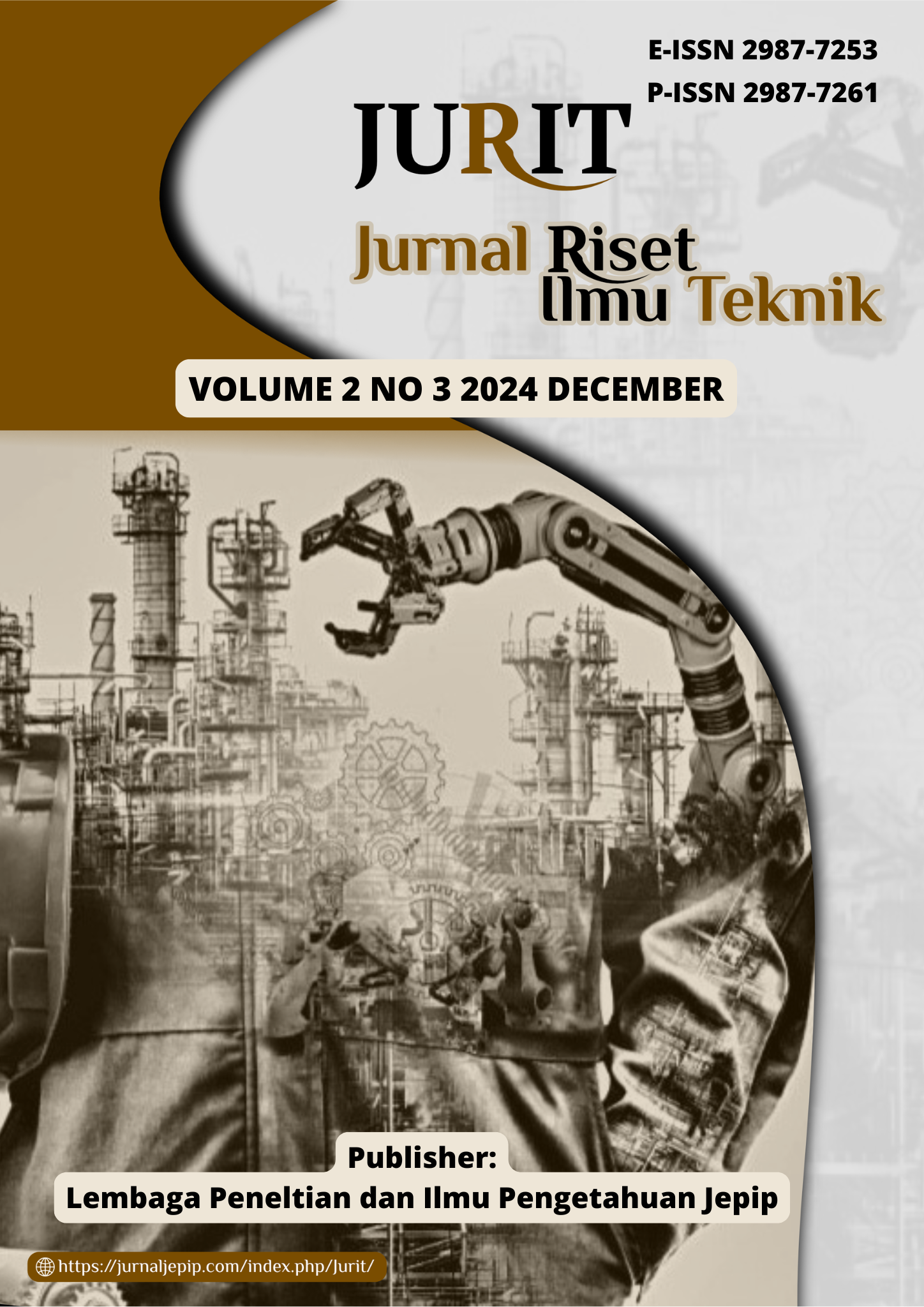Forecasting–Inventory Optimization Model: Integrating Exponential Smoothing with Min–Max and Blanket Order Systems For SMEs
DOI:
https://doi.org/10.59976/jurit.v2i3.140Abstract
Purpose –The research integrates demand forecasting using the Exponential Smoothing (ES) method to develop an adaptive and data-driven framework for cost optimization in volatile demand conditions. Methodology – A quantitative–descriptive and analytical approach was adopted by combining forecasting accuracy analysis with cost comparison modeling. Two forecasting models—Moving Average (MA) and Exponential Smoothing (ES)—were tested using 2021–2023 demand data. The most accurate model (lowest MAPE) was used to simulate inventory performance through the Min–Max and Blanket Order systems. Sensitivity analysis with ±10% demand variation was conducted to evaluate model robustness, while correlation testing validated forecast accuracy against actual demand. Findings – The Exponential Smoothing model achieved superior predictive accuracy (MAPE = 0.883%) compared with the Moving Average model (MAPE = 1.338%). The Min–Max Stock system produced lower total costs—IDR 116,269,920 (2021), IDR 123,260,400 (2022), and IDR 128,466,720 (2023)—compared with the Blanket Order system, which recorded higher and more volatile costs across the same period. The hybrid Min–Max–Forecasting approach demonstrated higher stability under demand fluctuations and improved procurement efficiency, achieving an estimated 30% cost reduction. Practical implications – This study offers SMEs an evidence-based strategy for integrating forecasting accuracy into inventory control, supporting cost reduction and production continuity in resource-constrained environments. The model can be adopted as a reference for developing adaptive inventory policies within the Indonesian SME food sector. Originality– The originality of this study lies in its hybrid integration of Exponential Smoothing forecasting within comparative Min–Max and Blanket Order frameworks, offering empirical validation for forecasting-driven inventory decisions at the SME scale. The approach provides both theoretical advancement and managerial relevance by aligning predictive accuracy with inventory cost optimization in volatile market contexts.
References
G. Dudek, “A Hybrid Residual Dilated LSTM and Exponential Smoothing Model for Midterm Electric Load Forecasting,” IEEE Trans. Neural Networks Learn. Syst., vol. 33, no. 7, pp. 2879–2891, 2022, doi: 10.1109/TNNLS.2020.3046629.
T. Sathish, “Exponential smoothing method against the gradient boosting machine learning algorithm-based model for materials forecasting to minimize inventory,” Aip Adv., vol. 14, no. 6, 2024, doi: 10.1063/5.0208491.
C. Rao, “Energy demand forecasting in China: A support vector regression-compositional data second exponential smoothing model,” Energy, vol. 263, 2023, doi: 10.1016/j.energy.2022.125955.
J. Shi, “A dual attention LSTM lightweight model based on exponential smoothing for remaining useful life prediction,” Reliab. Eng. Syst. Saf., vol. 243, 2024, doi: 10.1016/j.ress.2023.109821.
Y. Xie, “Real-Time Prediction of Docker Container Resource Load Based on a Hybrid Model of ARIMA and Triple Exponential Smoothing,” IEEE Trans. Cloud Comput., vol. 10, no. 2, pp. 1386–1401, 2022, doi: 10.1109/TCC.2020.2989631.
M. B. A. Rabbani, “A Comparison Between Seasonal Autoregressive Integrated Moving Average (SARIMA) and Exponential Smoothing (ES) Based on Time Series Model for Forecasting Road Accidents,” Arab. J. Sci. Eng., vol. 46, no. 11, pp. 11113–11138, 2021, doi: 10.1007/s13369-021-05650-3.
H. M. Zhao, “Measuring the impact of an exogenous factor: An exponential smoothing model of the response of shipping to COVID-19,” Transp. Policy, vol. 118, pp. 91–100, 2022, doi: 10.1016/j.tranpol.2022.01.015.
W. Sulandari, “Exponential Smoothing on Modeling and Forecasting Multiple Seasonal Time Series: An Overview,” 2021. doi: 10.1142/S0219477521300032.
D. Guleryuz, “Forecasting outbreak of COVID-19 in Turkey; Comparison of Box–Jenkins, Brown’s exponential smoothing and long short-term memory models,” Process Saf. Environ. Prot., vol. 149, pp. 927–935, 2021, doi: 10.1016/j.psep.2021.03.032.
G. Yang, “Short-term Load Forecasting Based on Holt-Winters Exponential Smoothing and Temporal Convolutional Network,” Dianli Xitong Zidonghua Autom. Electr. Power Syst., vol. 46, no. 6, pp. 73–82, 2022, doi: 10.7500/AEPS20210409003.
S. Smyl, “ES-dRNN: A Hybrid Exponential Smoothing and Dilated Recurrent Neural Network Model for Short-Term Load Forecasting,” IEEE Trans. Neural Networks Learn. Syst., vol. 35, no. 8, pp. 11346–11358, 2024, doi: 10.1109/TNNLS.2023.3259149.
I. Svetunkov, “Complex exponential smoothing,” Nav. Res. Logist., vol. 69, no. 8, pp. 1108–1123, 2022, doi: 10.1002/nav.22074.
C. Deng, “Equipping seasonal exponential smoothing models with particle swarm optimization algorithm for electricity consumption forecasting,” Energies, vol. 14, no. 13, 2021, doi: 10.3390/en14134036.
T. Alam, “A Comparative Study of CO2Emission Forecasting in the Gulf Countries Using Autoregressive Integrated Moving Average, Artificial Neural Network, and Holt-Winters Exponential Smoothing Models,” Adv. Meteorol., vol. 2021, 2021, doi: 10.1155/2021/8322590.
I. Svetunkov, “A new taxonomy for vector exponential smoothing and its application to seasonal time series,” Eur. J. Oper. Res., vol. 304, no. 3, pp. 964–980, 2023, doi: 10.1016/j.ejor.2022.04.040.
J. L. R. N. Cunha, “A hybrid model based on STL with simple exponential smoothing and ARMA for wind forecast in a Brazilian nuclear power plant site,” Nucl. Eng. Des., vol. 421, 2024, doi: 10.1016/j.nucengdes.2024.113026.
G. Moiseev, “Forecasting oil tanker shipping market in crisis periods: Exponential smoothing model application,” Asian J. Shipp. Logist., vol. 37, no. 3, pp. 239–244, 2021, doi: 10.1016/j.ajsl.2021.06.002.
M. H. P. Swari, “Comparison of Simple Moving Average, Single and Modified Single Exponential Smoothing,” 2021. doi: 10.1109/ITIS53497.2021.9791516.
C. Yu, “Time series analysis and forecasting of the Hand-Foot-Mouth disease morbidity in China using an advanced exponential smoothing state space TBATS model,” Infect. Drug Resist., vol. 14, pp. 2809–2821, 2021, doi: 10.2147/IDR.S304652.
G. Fu, “Look-ahead prediction of spindle thermal errors with on-machine measurement and the cubic exponential smoothing-unscented Kalman filtering-based temperature prediction model of the machine tools,” Meas. J. Int. Meas. Confed., vol. 210, 2023, doi: 10.1016/j.measurement.2023.112536.
S. K. Safi, “A hybrid of artificial fneural network, exponential smoothing, and ARIMA models for COVID-19 time series forecasting,” Model Assist. Stat. Appl., vol. 16, no. 1, pp. 25–35, 2021, doi: 10.3233/MAS-210512.
F. E. Sapnken, “A whale optimization algorithm-based multivariate exponential smoothing grey-holt model for electricity price forecasting,” Expert Syst. Appl., vol. 255, 2024, doi: 10.1016/j.eswa.2024.124663.
U. M. Butt, “Hybrid of deep learning and exponential smoothing for enhancing crime forecasting accuracy,” PLoS One, vol. 17, no. 9, 2022, doi: 10.1371/journal.pone.0274172.
W. Wei, “Time series prediction for the epidemic trends of monkeypox using the ARIMA, exponential smoothing, GM (1, 1) and LSTM deep learning methods,” J. Gen. Virol., vol. 104, no. 4, 2023, doi: 10.1099/jgv.0.001839.
S. Hansun, “Prediction of jakarta city air quality index: Modified double exponential smoothing approaches,” Int. J. Innov. Comput. Inf. Control, vol. 17, no. 4, pp. 1363–1371, 2021, doi: 10.24507/ijicic.17.04.1363.
M. Udenio, “Exponential smoothing forecasts: taming the bullwhip effect when demand is seasonal,” Int. J. Prod. Res., vol. 61, no. 6, pp. 1796–1813, 2023, doi: 10.1080/00207543.2022.2048114.
V. W. Nirmala, “Sales Forecasting by Using Exponential Smoothing Method and Trend Method to Optimize Product Sales in PT. Zamrud Bumi Indonesia During the Covid-19 Pandemic,” Int. J. Eng. Sci. Inf. Technol., vol. 1, no. 4, pp. 59–64, 2021, doi: 10.52088/ijesty.v1i1.169.
L. Kumar, “A comparative assessment of holt winter exponential smoothing and autoregressive integrated moving average for inventory optimization in supply chains,” Supply Chain Anal., vol. 8, 2024, doi: 10.1016/j.sca.2024.100084.
L. Rubio, “Ebitda index prediction using exponential smoothing and arima model,” Mathematics, vol. 9, no. 20, 2021, doi: 10.3390/math9202538.
I. Djakaria, “Covid-19 forecast using Holt-Winters exponential smoothing,” 2021. doi: 10.1088/1742-6596/1882/1/012033.
M. R. Fauzi, “State-of-Health Prediction of Lithium-Ion Batteries Using Exponential Smoothing Transformer With Seasonal and Growth Embedding,” IEEE Access, vol. 12, pp. 14659–14670, 2024, doi: 10.1109/ACCESS.2024.3357736.
M. H. P. Swari, “Optimization of Single Exponential Smoothing using Particle Swarm Optimization and Modified Particle Swarm Optimization in Sales Forecast,” 2022. doi: 10.1109/ITIS57155.2022.10010034.
E. Kahraman, “Comparison of exponential smoothing methods in forecasting global prices of main metals,” Miner. Econ., vol. 36, no. 3, pp. 427–435, 2023, doi: 10.1007/s13563-022-00354-y.
E. Kolemen, “A new deep recurrent hybrid artificial neural network of gated recurrent units and simple seasonal exponential smoothing,” Granul. Comput., vol. 9, no. 1, 2024, doi: 10.1007/s41066-023-00444-4.
Downloads
Published
How to Cite
Issue
Section
License
Copyright (c) 2024 Vivi Zibade Mutiara vivizibade, Erik Halomoan Syah

This work is licensed under a Creative Commons Attribution 4.0 International License.





















